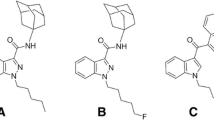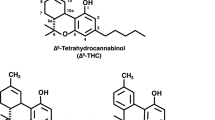Abstract
Purpose
MDMB-CHMICA, a new synthetic cannabinoid (SC), has become prevalent since 2014 as an ingredient of recreational drugs. Reports on intoxication due to the drug have been increasing, which show diverse cardiovascular, psychiatric, and neuronal symptoms. Reports on sudden death and accidental death related to psychiatric disorders in MDMB-CHMICA intoxication have also increased, but the underlying mechanisms are largely unknown.
Methods
As there has been no experimental study on the drug, we investigated the effects of peripheral injection of MDMB-CHMICA in conscious rats.
Results
MDMB-CHMICA induced rapid bradycardia and a slow pressor response. Cardiovascular responses to other SCs have been shown to be inhibited only by cannabinoid receptor-1 (CB1)-antagonists. However, the MDMB-CHMICA-induced bradycardia was inhibited not only by a CB1-antagonist, AM281, but also by a CB2-antagonist, AM630. Unlike other SCs, MDMB-CHMICA induced a gradual increase in mean blood pressure, which was marginally enhanced by the CB1- and CB2- antagonists. For the first time, we demonstrated that MDMB-CHMICA induces a thrashing hypermobile behavior in a CB1- and CB2-receptor-dependent manner, following catalepsy-like hypomobile behavior.
Conclusions
This unexpected response to MDMB-CHMICA may help explain the mechanisms underlying the sudden deaths and accidents associated with its use.



Similar content being viewed by others
References
WHO (2016) MDMB-CHMICA, critical review report, agenda item 4.9. http://www.who.int/medicines/access/controlled-substances/4.9_MDMB-CHMICA_CritReview.pdf. Accessed 14 Feb 2017
EMCDDA (2016) EMCDDA-Europol Joint Report on a new psychoactive substance: methyl 2-[[1-(cyclohexylmethyl) indol-3-carbonyl] amino]-3, 3-dimethylbutanoate (MDMB-CHMICA). https://doi.org/10.2810/08132
Hill SL, Najafi J, Dunn M, Acheampong P, Kamour A, Grundlingh J, Blain PG, Thomas SHL (2016) Clinical toxicity following analytically confirmed use of the synthetic cannabinoid receptor agonist MDMB-CHMICA. A report from the Identification Of Novel psychoActive substances (IONA) study. Clin Toxicol 54:638–643. https://doi.org/10.1080/15563650.2016.1190980
Seywright A, Torrance HJ, Wylie FM, McKeown DA, Lowe DJ, Stevenson R (2016) Analysis and clinical findings of cases positive for the novel synthetic cannabinoid receptor agonist MDMB-CHMICA. Clin Toxicol 54:632–637. https://doi.org/10.1080/15563650.2016.1186805
Westin AA, Frost J, Brede WR, Gundersen POM, Einvik S, Aarset H, Slørdal L (2016) Sudden cardiac death following use of the synthetic cannabinoid MDMB-CHMICA. J Anal Toxicol 40:86–87. https://doi.org/10.1093/jkt/bkv110
Adamowicz P (2016) Fatal intoxication with synthetic cannabinoid MDMB-CHMICA. Forensic Sci Int 261:e5–e10. https://doi.org/10.1016/j.forsciint.2016.02.024
Randall MD, Kendall DA, O’Sullivan S (2004) The complexities of the cardiovascular actions of cannabinoids. Br J Pharmacol 142:20–26. https://doi.org/10.1038/sj.bjp.0705725
Banister SD, Longworth M, Kevin R, Sachdev S, Santiago M, Stuart J, Mack JB, Glass M, McGregor IS, Connor M, Kassiou M (2016) Pharmacology of valinate and tert-leucinate synthetic cannabinoids 5F-AMBICA, 5F-AMB, 5F-ADB, AMB-FUBINACA, MDMB-FUBINACA, MDMB-CHMICA, and their analogues. ACS Chem Neurosci 7:1241–1254. https://doi.org/10.1021/acschemneuro.6b00137
Niederhoffer N, Schmid K, Szabo B (2003) The peripheral sympathetic nervous system is the major target of cannabinoids in eliciting cardiovascular depression. Naunyn Schmiedebergs Arch Pharmacol 367:434–443. https://doi.org/10.1007/s0010-003-0755-y
Gardiner SM, March JE, Kemp PA, Bennett T (2002) Influence of the CB1 receptor antagonist, AM 251, on the regional haemodynamic effects of WIN-55212-2 or HU 210 in conscious rats. Br J Pharmacol 136:581–587. https://doi.org/10.1038/sj.bjp.0704750
Niederhoffer N, Szabo B (2000) Cannabinoids cause central sympathoexcitation and bradycardia in rabbits. J Pharmacol Exp Ther 294:707–713. http://jpet.aspetjournals.org/content/jpet/294/2/707.fll.pdf
Niederhoffer N, Szabo B (1999) Effect of the cannabinoid receptor agonist WIN55212-2 on sympathetic cardiovascular regulation. Br J Pharmacol 126:457–466. https://doi.org/10.1038/sj.bjp.0702337
Gardiner SM, March JE, Kemp PA, Bennett T (2001) Regional haemodynamic responses to the cannabinoid agonist, WIN 55212-2, in conscious, normotensive rats, and in hypertensive, transgenic rats. Br J Pharmacol 133:445–453. https://doi.org/10.1038/sj.bjp.0704100
AlSuleimani YM, Hiley CR (2013) Mechanisms of vasorelaxation induced by oleoylethanolamide in the rat small mesenteric artery. Eur J Pharmacol 702:1–11. https://doi.org/10.1016/j.ejphar.2013.01.006
Bonz A, Laser M, Küllmer S, Kniesch S, Babin-Ebell J, Popp V, Ertl G, Wagner JA (2003) Cannabinoids acting on CB1 receptors decrease contractile performance in human atrial muscle. J Cardiovasc Pharmacol 41:657–664 (PMID:12658069)
Krylatov AV, Maslov LN, Ermakov SY, Barzakh EI, Lasukova OV, Crawford D, Ghadessy R, Serebrov VY (2006) Negative chronotropic effect of cannabinoids and their water-soluble emulsion is related to activation of cardiac CB1 receptors. Bull Exp Biol Med 142:450–453. https://doi.org/10.1007/s10517-006-0389-4
Gonzalez C, Herradon E, Abalo R, Vera G, Perez-Nievas BG, Leza JC, Martin MI, Lopez-Miranda V (2011) Cannabinoid/agonist WIN 55,212-2 reduces cardiac ischaemia-reperfusion injury in zucker diabetic fatty rats: role of CB2 receptors and iNOS/eNOS. Diabetes Metab Res Rev 27:331–340. https://doi.org/10.1002/dmrr.1176
Spaderna M, Addy PH, D’Souza DC (2013) Spicing things up: synthetic cannabinoids. Psychopharmacology 228:525–540. https://doi.org/10.1007/s00213-013-3188-4
Sano K, Mishima K, Koushi E, Orito K, Egashira N, Irie K, Takasaki K, Katsurabayashi S, Iwasaki K, Uchida N, Egawa T, Kitamura Y, Nishimura R, Fujiwara M (2008) Delta 9-tetrahydrocannabinol-induced catalepsy-like immobilization is mediated by decreased 5-HT neurotransmission in the nucleus accumbens due to the action of glutamate-containing neurons. Neuroscience 151:320–328. https://doi.org/10.1016/j.neuroscience.2007.10.026
McLaughlin PJ, Lu D, Winston KM, Thakur G, Swezey LA, Makriyannis A, Salamone JD (2005) Behavioral effects of the novel cannabinoid full agonist AM 411. Pharmacol Biochem Behav 81:78–88. https://doi.org/10.1016/j.pbb.2005.02.005
Simmons JR, Skinner CG, Williams J, Kang CS, Schwartz MD, Wills BK (2011) Intoxication from smoking “spice”. Ann Emerg Med 57:187–188. https://doi.org/10.1016/j.annemergmed.2010.08.039
Acknowledgements
This study is supported by a grant-in-aid of the Ministry of Education, Culture, Sports and Technology of Japan (No. 16K09218). We would like to thank Editage (www.editage.jp) for English language editing.
Author information
Authors and Affiliations
Corresponding author
Ethics declarations
Conflict of interest
There are no financial or other relations that could lead to a conflict of interest.
Ethical approval
The use of animals for this study was approved by the Experimental Animal Committee of Tokyo Medical University (approval number: S28066). This article does not contain any studies with human participants.
Electronic supplementary material
Below is the link to the electronic supplementary material.
Rights and permissions
About this article
Cite this article
Maeda, H., Nagashima, E., Hayashi, Y.K. et al. MDMB-CHMICA induces thrashing behavior, bradycardia, and slow pressor response in a CB1- and CB2-receptor-dependent manner in conscious rats. Forensic Toxicol 36, 313–319 (2018). https://doi.org/10.1007/s11419-018-0405-1
Received:
Accepted:
Published:
Issue Date:
DOI: https://doi.org/10.1007/s11419-018-0405-1




